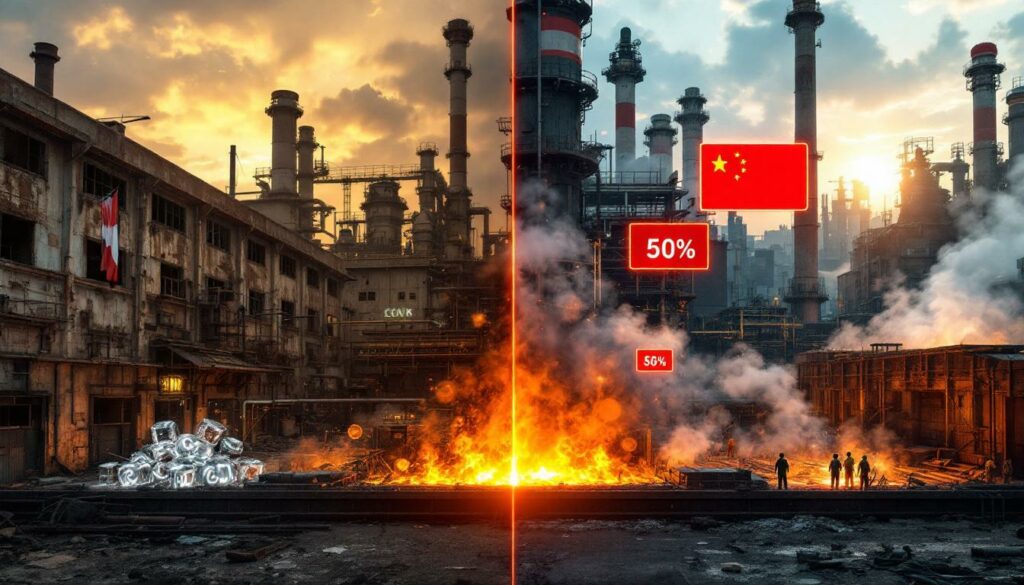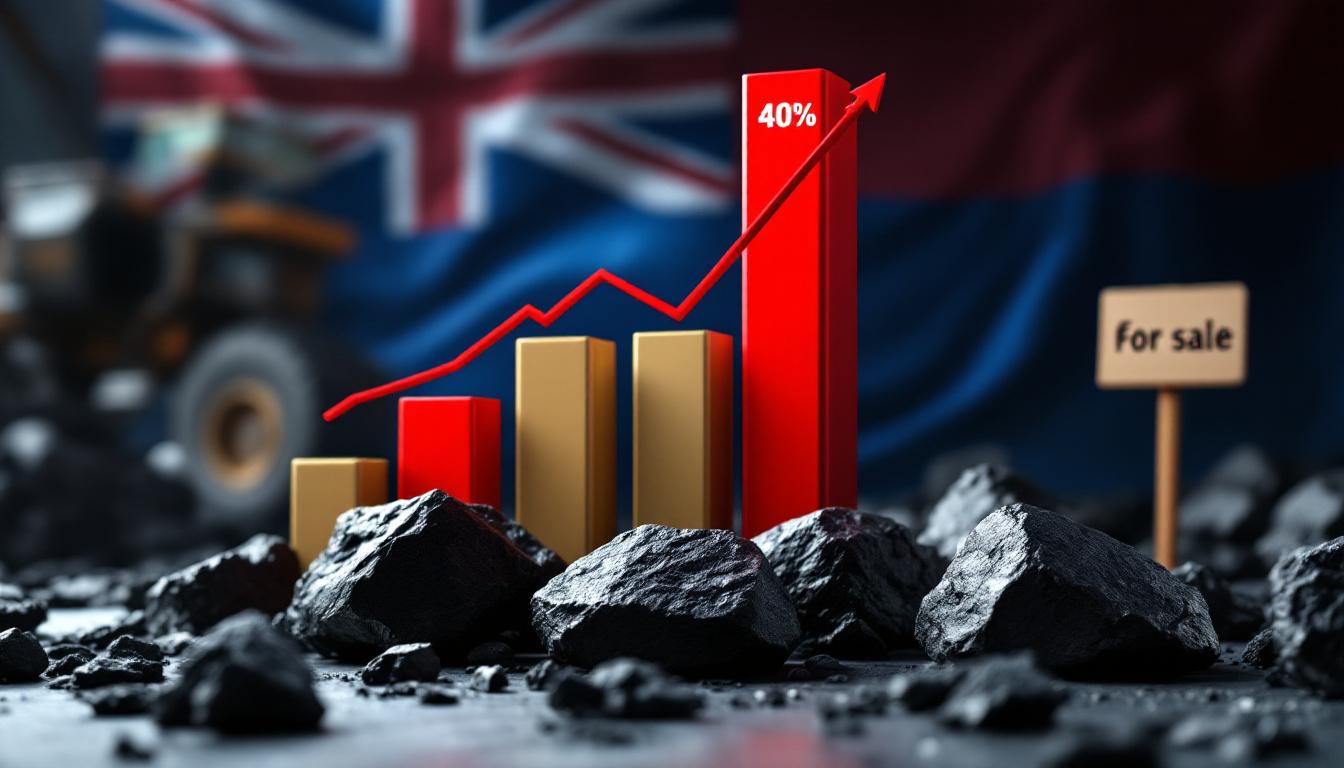The Critical Minerals Smelting Crisis: How Western Nations Are Losing Processing Power
The Western world faces a growing crisis in metals processing that threatens to undermine supply chain security for critical minerals. China's aggressive expansion of smelting capacity is creating unsustainable market conditions that are forcing Western smelters to close, placing entire supply chains at risk.
A dangerous pattern has emerged over the past decade: while Western nations focus on mining industry innovation, China has strategically targeted the processing stage, creating bottlenecks that threaten industrial security across multiple sectors. This calculated approach has allowed China to control critical metals flows without necessarily owning the mines that produce them.
"Western metal smelters are in crisis. China's rapid expansion of processing capacity is crushing margins across the metallic spectrum," notes Andy Home, Reuters metals columnist.
This dominance extends across multiple metals markets, with Chinese entities now controlling approximately 60% of global aluminum production and nearly 50% of zinc refining capacity. The implications reach far beyond simple market competition, threatening Western industrial capabilities in aerospace, defense, and renewable energy.
The Economic Pressure Points
Western smelters face multiple economic challenges that make competition with Chinese operations increasingly difficult:
- Treatment charges collapse: Processing fees for copper have fallen to zero or negative levels in spot markets, meaning smelters actually pay miners for raw materials
- Zinc processing fees in freefall: Zinc smelter charges reached negative territory in Q4 2024, with spot rates of $55 per metric ton sitting well below the $80 benchmark (itself a 50-year low)
- Energy cost disadvantage: Western facilities face power costs 3-4 times higher than Chinese competitors
- Government subsidy imbalance: Chinese smelters receive state support that Western operations cannot match
- Vertical integration advantage: Chinese firms can offset processing losses across their integrated value chains
The economic pressure has become so severe that industry giant Glencore described current treatment charges as "economically irrational" during their 2024 earnings call.
Recent Smelter Casualties
The crisis has already claimed several high-profile victims:
- Copper smelters in Namibia and the Philippines were placed into care and maintenance in early 2025
- Glencore copper shutdown in Mount Isa, Australia faces imminent closure without government intervention
- Nyrstar's zinc and lead smelters in Australia required emergency government support packages in 2024
- Rio Tinto's Tomago aluminum smelter entered bailout discussions with Australian authorities in May 2025
These closures represent more than lost industrial assets—they signify the erosion of Western technical capability in metallurgical processing, expertise that once lost is difficult to rebuild.
How Has China Dominated Global Metal Processing?
China's strategic focus on controlling the middle of the supply chain—processing rather than mining—has created concerning levels of market concentration across multiple metals. This approach provides maximum leverage with minimum resource investment.
"China doesn't dominate global mining but rather the intermediate stage where value is added by converting ore into metal," explains a 2024 analysis from the International Energy Agency.
The strategy has proven remarkably effective. By controlling processing, China can effectively dictate terms to both upstream miners and downstream manufacturers, creating a strategic chokepoint in global supply chains.
China's Growing Market Share
The statistics reveal a clear pattern of growing Chinese dominance:
- Refined zinc production: increased from 33% of global market in 2007 to nearly 50% in 2024
- Primary aluminum: approximately 60% of global output now occurs in China
- Aluminum semi-manufactured products: exports grew from 2 million tons in 2010 to 6 million tons in 2024
- Nickel production: China-backed Indonesian operations now account for ~50% of global production
This concentration creates significant security vulnerabilities, as Western economies become increasingly dependent on potentially unreliable processing capacity.
The Expansion Beyond China's Borders
China's processing strategy has expanded beyond its borders in recent years:
- Indonesian nickel processing boom driven by over $18 billion in Chinese investment since 2020
- New aluminum smelting capacity being constructed in Indonesia to circumvent China's 45-million-ton capacity cap
- Chinese operators expanding influence throughout Southeast Asia, particularly Vietnam and Malaysia
This offshore expansion allows China to maintain control while evading domestic environmental regulations and capacity limits, creating a shadow processing network that extends Chinese influence without appearing in official statistics.
Why Are Treatment Charges Collapsing?
The processing fees that smelters charge miners to convert ore concentrates into refined metal have traditionally been their primary revenue stream. These charges are now being squeezed to unsustainable levels, threatening the entire Western smelting industry.
The Market Inversion Phenomenon
A remarkable market inversion has occurred in recent years:
- Copper smelters now paying miners for raw material in spot markets—a complete reversal of traditional practice
- Annual benchmark copper treatment charges reaching historic lows of $78 per ton in 2025 negotiations
- Zinc spot treatment charges fell to $55 per metric ton, well below the $80 benchmark (itself a 50-year low)
- Oversupply of processing capacity relative to available mine output has fundamentally altered power dynamics
This inversion creates an unsustainable business model for Western smelters, which lack the government support and vertical integration that allows Chinese competitors to operate through price downturns.
The Supply-Demand Imbalance
The core problem is a fundamental mismatch between processing capacity and mine output:
- Zinc mine production increased 5.1% year-on-year in early 2025
- China's zinc concentrate imports more than doubled to over 2.2 million tons in first five months of 2025
- Chinese smelting capacity expanding at 8% annually, far outpacing global mine production growth of 3%
- Market implosion driven by capacity mismatch rather than mine supply constraints
"The problem is not simply constrained mine supply… Chinese smelting capacity [expands] over and beyond what the world's mines can feasibly supply," notes industry analyst CRU Group.
This imbalance creates a situation where Chinese smelters can effectively set pricing terms, using their scale and government backing to outlast Western competitors in a war of attrition.
What Makes Western Smelters Strategic Assets?
Beyond their commercial value, Western smelters serve critical strategic functions in securing supply chains and providing access to valuable by-products. These facilities represent technological capabilities that, once lost, are difficult to reconstruct.
Critical Supply Chain Linkages
Smelters provide essential services within industrial ecosystems:
- Connect mines to end-users of refined metals through technical expertise
- Reduce dependency on potentially hostile suppliers by maintaining domestic processing capacity
- Ensure market access for domestic mining operations, preventing stranded assets
- Provide technical expertise and skilled employment in metallurgical sciences
- Enable national manufacturing self-sufficiency during supply disruptions
These strategic benefits often go uncounted in purely economic assessments of smelter viability.
By-Product Recovery Potential
Modern smelters recover numerous critical minerals as by-products of their main operations:
- Gallium can be extracted from the "red mud" waste of aluminum smelting processes (approximately 150ppm concentration)
- Rio Tinto's Kennecott copper smelter now produces tellurium, essential for thin-film solar panels
- Nyrstar's Port Pirie facility could produce strategic antimony loan opportunities if operations continue
- Precious metals recovery (gold, silver) from copper concentrates generates 15-30% of revenue for some smelters
- Sulfuric acid production as valuable smelting by-product supplies agricultural and chemical industries
Sweden's Boliden generates approximately 30% of revenue from by-products at its Rönnskär smelter, demonstrating the potential value beyond primary metal production.
"Western smelters are discovering that critical mineral recovery can transform marginal operations into strategic assets," explains the International Copper Study Group.
The loss of these capabilities would increase Western dependency on Chinese suppliers for these specialized materials, many of which are essential for defense and green energy applications.
How Does Energy Cost Impact Western Smelters?
Energy represents a major portion of smelting costs, particularly for aluminum production, and Western facilities face significant disadvantages in this area. The energy price differential creates a structural competitive imbalance that even the most efficient Western operations struggle to overcome.
The Power Price Disadvantage
Energy price differentials create substantial operating cost gaps:
- European smelters hit hard by energy price spikes following Russia's Ukraine invasion, with some facilities seeing 300% increases
- Aluminum smelting particularly vulnerable due to electricity-intensive electrolysis process (40% of operating costs)
- Competition with tech sector for available power capacity in Western markets
- Renewable energy transition creating temporary supply constraints and price volatility
- Chinese power costs for industrial users approximately 60% lower than European equivalents
For aluminum smelters, which consume approximately 14,000 kWh per ton of metal produced, even small energy price differentials translate into major competitive disadvantages.
Policy Responses to Energy Challenges
Western governments are beginning to address these energy challenges:
- EU "Action Plan" prioritizing grid access for energy-intensive sectors announced in March 2025
- Promotion of power purchase agreements to stabilize costs over 10-15 year horizons
- Potential government subsidies to offset energy price disadvantages during transition periods
- Investment in on-site renewable generation at smelting facilities to reduce grid dependency
- Industrial electricity tariff restructuring to protect strategic manufacturing
Australian authorities recently approved a specialized energy purchase agreement for the Tomago aluminum smelter, recognizing its strategic importance to national manufacturing capacity.
What Parallels Exist With Other Critical Minerals?
The metals smelting and the west's critical minerals crisis mirrors China's existing dominance in other critical mineral supply chains, suggesting a consistent strategic approach to controlling global materials processing. The pattern of targeting processing rather than mining appears across multiple commodities.
The Rare Earths Precedent
China's control of rare earth processing provides a concerning precedent:
- Export controls implemented on certain rare earth elements in 2023
- Dominance in processing (90% market share) rather than mining (60% share) creates leverage
- Strategic targeting of intermediate processing stages with highest technical barriers
- Capacity to weaponize supply chains for geopolitical advantage during trade disputes
The rare earths case demonstrates that control of processing can be more strategically valuable than ownership of mines, as processing represents the technical chokepoint in the supply chain.
Other Vulnerable Supply Chains
Several other critical mineral supply chains show similar vulnerability patterns:
- China's export controls on gallium impacting semiconductor industry since July 2023
- Antimony supplies subject to Chinese export restrictions, affecting flame retardant and defense applications
- Tungsten and bismuth markets vulnerable to supply disruptions due to processing concentration
- Potential for similar control over base metal refining as Western capacity diminishes
"The pattern is consistent—China targets the processing stage that requires technical expertise but not necessarily resource ownership," notes the Critical Minerals Association.
This systematic approach suggests a coordinated strategy rather than coincidental market developments, raising significant national security concerns.
How Are Western Governments Responding?
As the strategic importance of domestic smelting capacity becomes clearer, Western governments are beginning to implement support measures. The policy response, however, remains fragmented and lacks the scale necessary to counter Chinese advantages.
Current Policy Approaches
Several initiatives have emerged:
- Australian government considering support package for at-risk smelters, including Tomago aluminum facility
- European Union developing comprehensive "Action Plan" for metals processing security, released in draft form April 2025
- Faster grid access for energy-intensive sectors prioritized in industrial policy
- Promotion of power purchase agreements through government guarantees
- Classified studies by Western defense departments assessing supply chain vulnerabilities
These responses, while encouraging, have yet to match the scale and coordination of China's strategic approach to metals processing.
Strategic Investment Considerations
The policy debate increasingly frames smelters as national security assets:
- Government financial support weighed against market principles and WTO compliance
- Public-private partnerships to maintain critical infrastructure through transition periods
- Investment in technological innovation to improve competitiveness of Western facilities
- Strategic stockpiling of processed metals to reduce short-term dependency
The U.S. Department of Defense has classified critical minerals processing as a "Tier 1" supply chain concern in its 2025 industrial capability assessment, signaling growing awareness of the strategic dimensions.
What Are the Long-Term Solutions?
Addressing the smelting crisis requires a multi-faceted approach that goes beyond short-term financial support. Sustainable solutions must address the structural disadvantages facing Western processors.
Technological Innovation Pathways
Several technological approaches could improve Western competitiveness:
- Energy efficiency improvements to reduce operating costs (potential 15-20% reduction)
- Process innovations to enhance by-product recovery, transforming waste streams into revenue
- Automation and digitalization to improve productivity and reduce labor costs
- Development of smaller, more flexible processing facilities better suited to Western energy markets
The Massachusetts Institute of Technology's "Green Processing Initiative" has identified potential breakthrough technologies that could reduce smelter energy consumption by up to 30% while improving by-product recovery rates.
Supply Chain Restructuring Options
Structural changes to Western supply chains could improve resilience:
- Vertical integration between mining and processing to balance profitability across the value chain
- Strategic alliances between Western producers to achieve competitive scale
- Diversification of processing locations to reduce concentration risks
- Development of processing hubs in energy-advantaged regions (e.g., hydropower-rich areas)
The Minerals Security Partnership, a diplomatic initiative involving 13 Western nations, has begun coordinating investment in processing capacity, though funding remains limited compared to Chinese expenditures.
What Are the Consequences of Inaction?
Failure to address the metals smelting and the west's critical minerals crisis could have far-reaching implications for Western economies and security. The potential impacts extend well beyond the immediate economic costs of facility closures.
Supply Chain Vulnerability Risks
Continued Western processing decline would create multiple vulnerabilities:
- Increased dependency on Chinese processing capacity for critical industrial inputs
- Vulnerability to export restrictions or processing fees during geopolitical tensions
- Limited ability to develop domestic mining operations due to concentrate market access constraints
- Reduced access to critical by-products essential for defense and renewable energy applications
These vulnerabilities would significantly constrain Western policy options during future trade or geopolitical disputes with China.
Economic and Security Impacts
The broader impacts include:
- Loss of high-skilled industrial jobs in metallurgical processing (typically paying 1.5x regional manufacturing averages)
- Reduced technological capability in metallurgical processing and materials science
- Strategic vulnerability in defense and clean energy supply chains dependent on refined metals
- Diminished ability to respond to supply disruptions during international crises
"The loss of domestic smelting represents more than economic damage—it's the erosion of industrial capability that cannot be quickly reconstructed during emergencies," warns a 2025 report from the Atlantic Council.
The compounding effects of these impacts could significantly constrain Western industrial resilience in coming decades.
How Can the West Rebuild Processing Capacity?
Rebuilding competitive Western processing capacity will require coordinated action across government, industry, and finance sectors. The challenge is substantial but not insurmountable with appropriate policy focus.
Policy Framework Requirements
Effective policy responses must include:
- Recognition of smelters as strategic national assets within industrial policy frameworks
- Coordinated industrial policy across Western nations to avoid harmful competition
- Energy policy aligned with industrial needs, including prioritized access and stable pricing
- Trade measures to counter unfair competition from subsidized operations
- Defense procurement policies that value supply chain security
Australia's 2025 Critical Infrastructure Protection framework provides a potential model, designating key processing facilities as nationally significant infrastructure with associated support mechanisms.
Investment and Innovation Priorities
Financial and technological strategies must focus on:
- Public-private partnerships for capital investment in next-generation processing facilities
- Research and development in energy-efficient processing technologies (potential 30% efficiency gains)
- By-product recovery technology enhancement to improve overall economics
- Workforce development and technical training to maintain metallurgical expertise
The EU's proposed €10 billion Critical Minerals Processing Fund represents a promising step, though industry analysts suggest €30-50 billion would be required to meaningfully address the capacity gap. Additionally, some countries are exploring mineral beneficiation opportunities to increase their domestic processing capabilities and reduce dependency on foreign processors.
Ultimately, addressing the smelting crisis will require a coordinated global response, including strategic partnerships showcased at events like the upcoming global mining innovation expo where new processing technologies will take center stage.
FAQs About the Metals Smelting Crisis
What is a treatment charge in metal smelting?
Treatment charges are fees that smelters collect from mining companies for processing ore concentrates into refined metal. These charges traditionally form the core revenue stream for smelting operations but have collapsed in recent years due to Chinese capacity expansion. For copper, these charges have fallen from historical averages of $100-150 per ton to near zero in spot markets during 2025.
Why can't Western smelters compete with Chinese facilities?
Western smelters face multiple disadvantages, including:
- Energy costs 3-4 times higher than Chinese
Want to Capitalise on the Next Major Mineral Discovery?
Stay ahead of the market with Discovery Alert's proprietary Discovery IQ model, which instantly notifies investors of significant ASX mineral discoveries and transforms complex data into actionable insights. Explore why major mineral discoveries can lead to substantial returns by visiting Discovery Alert's dedicated discoveries page.




